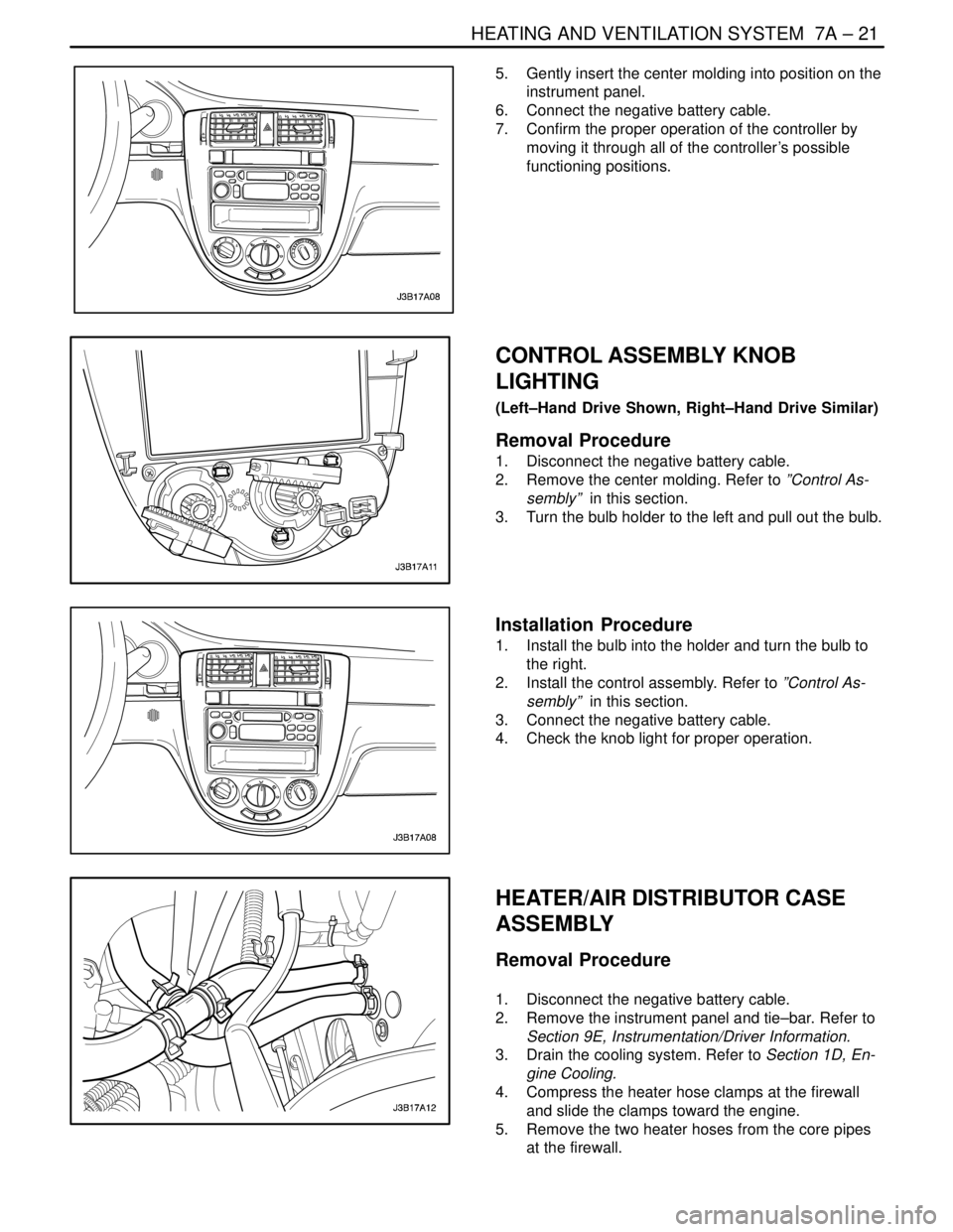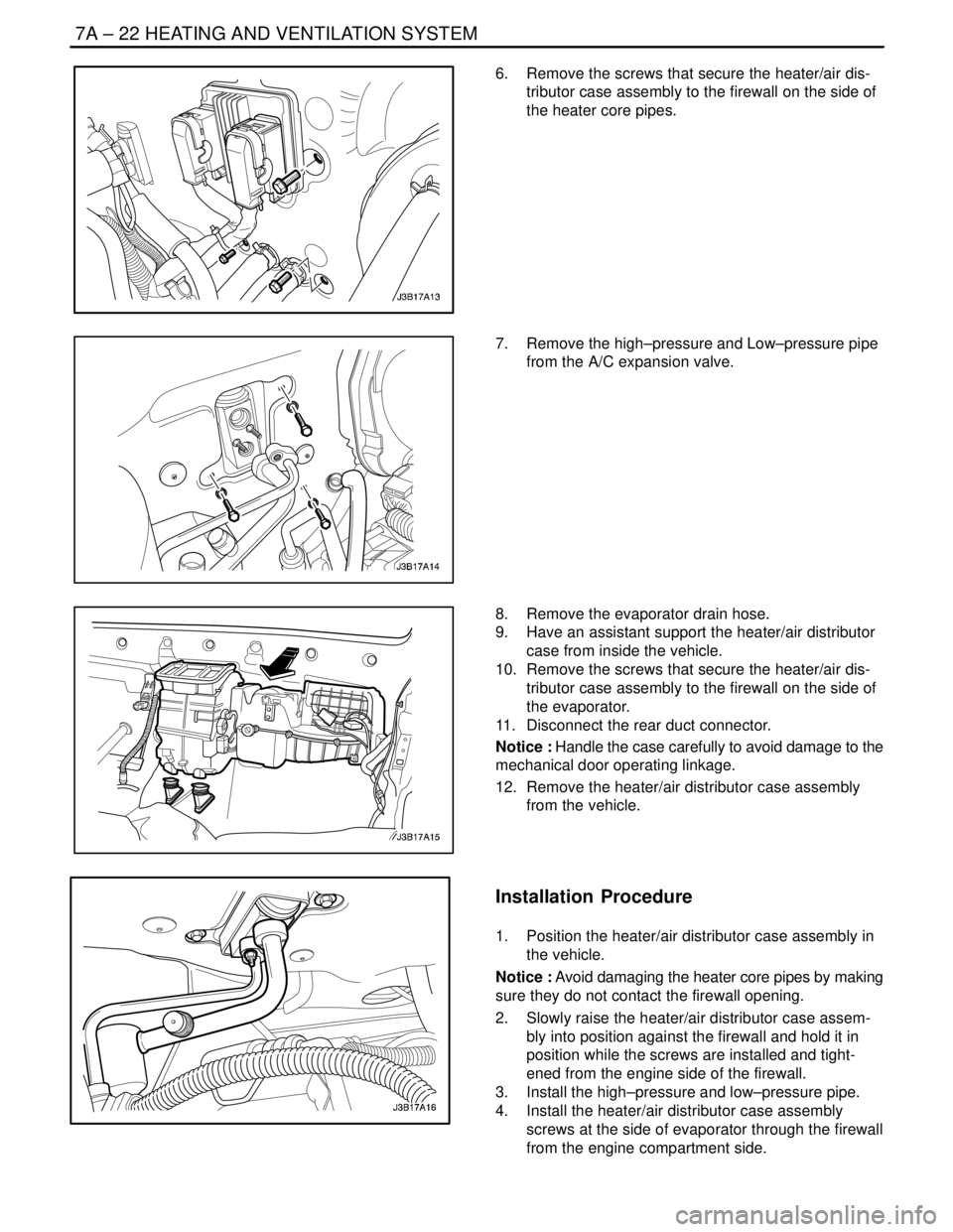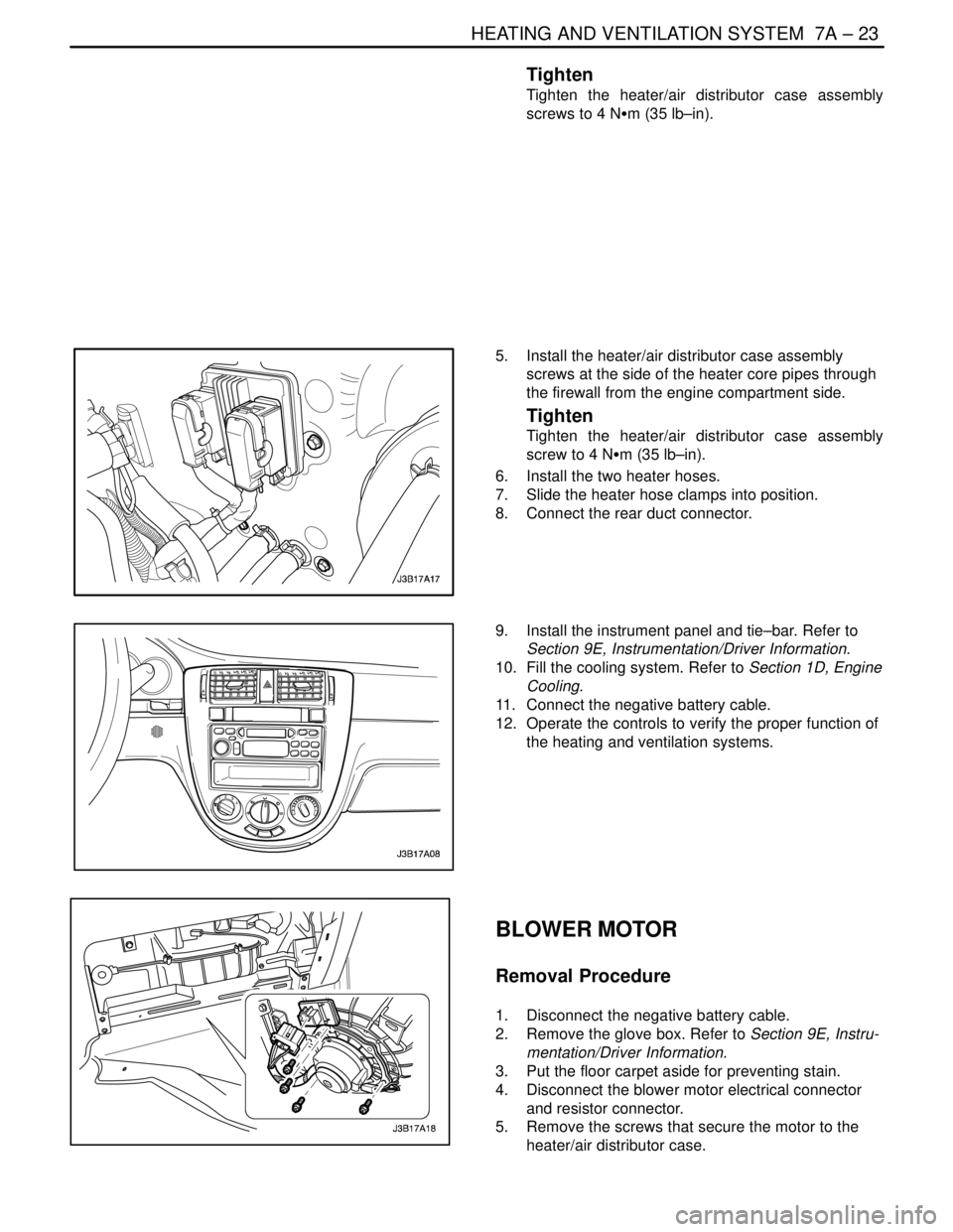2004 DAEWOO NUBIRA engine e
[x] Cancel search: engine ePage 1985 of 2643

HEATING AND VENTILATION SYSTEM 7A – 11
DAEWOO V–121 BL4
StepNo Yes Value(s) Action
211. Disconnect the resistor block connector.
2. Connect one lead of a self–powered test light
to any single lead on the resistor block. Use
the other lead to probe each of the other two
terminals.
Does the test light illuminate on all terminals?–Go to Step 23Go to Step 22
22Replace the resistor block.
Is the repair complete?–System OK–
231. Turn the ignition to LOCK.
2. Disconnect the connector from the resistor
block.
3. Connect a jumper lead from the positive termi-
nal on the battery to any wire terminal in the
connector.
4. Use a 12–volt test light to check for voltage
from the corresponding wire on the blower
speed switch.
5. Repeat the same test on the other wires.
Does the lamp light on all three wires?–Go to Step 25Go to Step 24
24Replace the blower speed switch.
Is the repair complete?–System OK–
25Repair the open in the affected wire.
Is the repair complete?–System OK–
IMPROPER AIR DELIVERY OR NO MODE SHIFT
This procedure provides a test of all functions of the heater/defroster unit.
1. Warm up the vehicle.
2. Keep the engine running.
3. Perform the tests outlined in the table below and look for the results indicated.
CONTROL SETTINGS
CORRECT RESULTS
Mode
KnobTe m p
Contro
lBlower
Motor
SwitchBlower
SpeedPower
Vent
OutletFloor
OutletDefrost
OutletSide
Window
Outlet
VentColdOffOffNo
AirflowNo
AirflowNo
AirflowNo
Airflow
VentCold4HighAmbient
AirflowNo
AirflowNo
AirflowNo
Airflow
FloorCold to
Hot4HighNo
AirflowCold to Hot
AirflowMinimum
Cold to Hot
AirflowMinimum
Cold to Hot
Airflow
De-
frosterCold to
Hot4HighNo
AirflowMinimum
Cold to Hot
AirflowCold to Hot
AirflowMinimum
Cold to Hot
Airflow
If any of these settings does not produce the correct results, perform the following diagnostic procedure.
Page 1986 of 2643

7A – 12IHEATING AND VENTILATION SYSTEM
DAEWOO V–121 BL4
StepActionValue(s)YesNo
1Verify the customer’s complaint.
Are the customer’s concerns verified?Go to Step 2System OK
2S Examine the affected door in the unit for proper
attachment to the vacuum actuator.
S Check the actuator connection to the door.
S Check that the vacuum hose is properly con-
nected.
Is everything connected properly?–Go to Step 4Go to Step 3
3Repair as necessary.
Is the repair complete?–System OK–
41. Disconnect the actuator at the door.
2. Check the range of the door travel and the ef-
fort required to move it.
Does the door move freely through its entire range
of travel so that it can close at both ends of the
range?–Go to Step 5Go to Step 3
5Check the travel of the actuator by turning the con-
trol knob with the engine running.
Is the actuator travel OK?–Go to Step 6Go to Step 7
61. Reinstall the actuator.
2. Recheck the system using the ”Control Set-
tings/Correct Results” tests in this procedure.
Does the system perform properly?–System OKGo to Step 9
71. Check the vacuum hose at the control.
2. Check for a broken control.
Is there a problem with the vacuum hose or the con-
trol?–Go to Step 8Go to Step 9
8Repair the vacuum hose or the control as necessary.
Is the repair complete?–System OKGo to Step 9
9Recheck the system using the ”Control Settings/
Correct Results” tests in this procedure.
Is the repair complete?–System OKGo to Step 10
10Check for airflow from the defroster or the vent out-
lets.
Is there high airflow from the defroster or the vent
outlets?–Go to Step 11Go to Step 12
11Adjust the heater door at the floor and the vent door
to get the proper airflow.
Is the repair complete?–System OK–
12Switch the mode knob to defrost.
Is the defroster airflow OK?–Go to Step 13Go to Step 14
131. Remove the heater outlet.
2. Check the heater outlet for obstructions.
3. Remove any obstructions in the heater outlet.
Is the repair complete?–System OK–
14Check the blower speeds for change in the airflow.
Does the blower speed increase as the control is
turned from 1 to 4?–Go to Step 15Go to ”Blower
Electrical
(Manual and
Non–A/C)”
Page 1988 of 2643

7A – 14IHEATING AND VENTILATION SYSTEM
DAEWOO V–121 BL4
StepNo Yes Value(s) Action
71. Check the temperature door travel, the cable,
and the linkage.
2. Adjust to full cold.
3. Check for full hot.
Is the repair complete?–System OK–
8Adjust or repair the floor/defroster and/or the vent/
floor mode.
Is the repair complete?–System OK–
9In the vent position, is the problem objectionable
bleed?–Go to Step 10Go to Step 15
101. Check the system case for leaks.
2. Check the floor outlet attachment.
Are there problems?–Go to Step 11Go to Step 12
11Repair the system case or the floor outlet attach-
ment as required.
Is the repair complete?–System OKGo to Step 12
121. Turn the ignition switch OFF.
2. Turn the temperature control knob to full hot,
then rapidly to full cold.
Do you hear the door slam just before you reach the
end of the control travel?–Go to Step 13Go to Step 14
13Adjust the vent door to vent more.
Is the repair complete?–System OK–
141. Check the temperature door travel, the cables,
and the linkage.
2. Verify that the temperature door goes to full
cold.
3. Check the temperature door for full hot.
Is the temperature door travel correct?–System OK–
151. Set the fresh air/recirculating air control to
fresh air (indicator lamp off).
2. Set the temperature control to full cold.
3. Start the vehicle and allow the engine to warm
up.
4. Measure the air temperature at the blower in-
let, or cowl, and at the vent air outlet inside the
vehicle.
Is the outlet air more than 5°C (41°F) warmer than
the inlet air?–Go to Step 16System OK
161. Check for hot air leaks from the engine
compartment to the blower inlet.
2. Repair, as needed.
Is the repair complete?–System OK–
Page 1990 of 2643

7A – 16IHEATING AND VENTILATION SYSTEM
DAEWOO V–121 BL4
BLOWER NOISE
StepActionValue(s)YesNo
1Verify the customer’s complaint.
Are the customer’s concerns verified?–Go to Step 2System OK
21. Sit inside the vehicle.
2. Close the doors and the windows.
3. Turn the ignition ON.
4. Start the engine.
5. Set the temperature to full cold.
6. Cycle through the blower speeds, the modes,
and the temperature settings in order to find
the noise.
Is the blower noise constant at high blower speeds
or certain modes, but absent at lower speeds or in
other modes?–Go to Step 11Go to Step 3
3Check for vibrations from the blower motor and fan
assembly at each blower speed by feeling the blower
motor housing.
Did you find excessive vibration?–Go to Step 6Go to Step 4
41. Remove the blower motor and the fan assem-
bly. Refer to ”Blower Motor” in this section.
2. Check for foreign material at the opening of the
blower inlet.
Do you find any foreign material at the blower inlet?–Go to Step 5Go to Step 6
5Remove all foreign material.
Is the repair complete?–System OKGo to Step 6
61. Examine the blower fan for wear spots,
cracked blades, a cracked hub, a loose fan re-
taining nut, or bad alignment.
2. Examine the blower case for wear spots.
Did you find any problem?–Go to Step 7Go to Step 9
7Repair as required.
Is the repair complete?–System OKGo to Step 8
8Replace the motor and the fan assembly.
Is the repair complete?–System OKGo to Step 9
9If the noise is a click/tick or whine, replace the motor.
Is the repair complete?–System OKGo to Step 10
10Reinstall the original motor.
Is the problem still present?–Go to Step 11System OK
111. Set the blower speed on maximum.
2. Check full–hot to full–cold temperature posi-
tions in the defrost, floor, and vent modes.
Is the noise present in the defrost mode only?–Go to Step 12Go to Step 13
121. Check the ducts for obstructions or foreign ma-
terials.
2. Remove any obstructions or foreign materials.
3. Check the floor/defroster door seals.
4. Repair or replace the components, as needed.
Is the repair complete?–System OK–
13Is the noise present in the floor mode only?–Go to Step 12Go to Step 14
14Is the noise present in the vent mode only?–Go to Step 15Go to Step 16
Page 1995 of 2643

HEATING AND VENTILATION SYSTEM 7A – 21
DAEWOO V–121 BL4
5. Gently insert the center molding into position on the
instrument panel.
6. Connect the negative battery cable.
7. Confirm the proper operation of the controller by
moving it through all of the controller’s possible
functioning positions.
CONTROL ASSEMBLY KNOB
LIGHTING
(Left–Hand Drive Shown, Right–Hand Drive Similar)
Removal Procedure
1. Disconnect the negative battery cable.
2. Remove the center molding. Refer to ”Control As-
sembly” in this section.
3. Turn the bulb holder to the left and pull out the bulb.
Installation Procedure
1. Install the bulb into the holder and turn the bulb to
the right.
2. Install the control assembly. Refer to ”Control As-
sembly” in this section.
3. Connect the negative battery cable.
4. Check the knob light for proper operation.
HEATER/AIR DISTRIBUTOR CASE
ASSEMBLY
Removal Procedure
1. Disconnect the negative battery cable.
2. Remove the instrument panel and tie–bar. Refer to
Section 9E, Instrumentation/Driver Information.
3. Drain the cooling system. Refer to Section 1D, En-
gine Cooling.
4. Compress the heater hose clamps at the firewall
and slide the clamps toward the engine.
5. Remove the two heater hoses from the core pipes
at the firewall.
Page 1996 of 2643

7A – 22IHEATING AND VENTILATION SYSTEM
DAEWOO V–121 BL4
6. Remove the screws that secure the heater/air dis-
tributor case assembly to the firewall on the side of
the heater core pipes.
7. Remove the high–pressure and Low–pressure pipe
from the A/C expansion valve.
8. Remove the evaporator drain hose.
9. Have an assistant support the heater/air distributor
case from inside the vehicle.
10. Remove the screws that secure the heater/air dis-
tributor case assembly to the firewall on the side of
the evaporator.
11. Disconnect the rear duct connector.
Notice : Handle the case carefully to avoid damage to the
mechanical door operating linkage.
12. Remove the heater/air distributor case assembly
from the vehicle.
Installation Procedure
1. Position the heater/air distributor case assembly in
the vehicle.
Notice : Avoid damaging the heater core pipes by making
sure they do not contact the firewall opening.
2. Slowly raise the heater/air distributor case assem-
bly into position against the firewall and hold it in
position while the screws are installed and tight-
ened from the engine side of the firewall.
3. Install the high–pressure and low–pressure pipe.
4. Install the heater/air distributor case assembly
screws at the side of evaporator through the firewall
from the engine compartment side.
Page 1997 of 2643

HEATING AND VENTILATION SYSTEM 7A – 23
DAEWOO V–121 BL4
Tighten
Tighten the heater/air distributor case assembly
screws to 4 NSm (35 lb–in).
5. Install the heater/air distributor case assembly
screws at the side of the heater core pipes through
the firewall from the engine compartment side.
Tighten
Tighten the heater/air distributor case assembly
screw to 4 NSm (35 lb–in).
6. Install the two heater hoses.
7. Slide the heater hose clamps into position.
8. Connect the rear duct connector.
9. Install the instrument panel and tie–bar. Refer to
Section 9E, Instrumentation/Driver Information.
10. Fill the cooling system. Refer to Section 1D, Engine
Cooling.
11. Connect the negative battery cable.
12. Operate the controls to verify the proper function of
the heating and ventilation systems.
BLOWER MOTOR
Removal Procedure
1. Disconnect the negative battery cable.
2. Remove the glove box. Refer to Section 9E, Instru-
mentation/Driver Information.
3. Put the floor carpet aside for preventing stain.
4. Disconnect the blower motor electrical connector
and resistor connector.
5. Remove the screws that secure the motor to the
heater/air distributor case.
Page 2002 of 2643

7A – 28IHEATING AND VENTILATION SYSTEM
DAEWOO V–121 BL4
GENERAL DESCRIPTION
AND SYSTEM OPERATION
HEATING AND VENTILATION
SYSTEMS
The base heater system is designed to provide heating,
ventilation, windshield defrosting, side window defogging,
and on some vehicles, heating directly to the rear seat
area.
The heater and fan assembly blower regulates the airflow
from the air inlet for further processing and distribution.
The heater core transfers the heat from the engine coolant
to the inlet air.
The temperature door regulates the amount of the air that
passes through the heater core. The temperature door
also controls the temperature of the air by controlling the
mix of the heated air and the ambient air.
The mode door regulates the flow and the distribution of
the processed air to the heater ducts and to the defroster
ducts.
This console–mounted heating and ventilation panel con-
tains the following:
The Rotary Temperature Control Knob
1. The Rotary Temperature Control Knob
S Actuates by cable.
S Raises the temperature of the air entering the
vehicle by rotation toward the right, or the red
portion of the knob.
2. The Rotary Blower Control Knob
S Turns ON to operate the blower motor at four
speeds.
S Turns OFF to stop the blower.
S Operates completely independently both from
the mode control that regulates the defroster
door and from the temperature control knob.S Changes the fan speed in any mode and at any
temperature setting.
3. The Rotary Mode Control Knob
S Actuates by cable.
S Regulates the air distribution between the wind-
shield, the instrument panel, and the floor vents.
Two Push Knobs
1. The Rear Window Defogger Push Knob
S Controls the rear window defogger.
S Turns ON the rear window defogger when the
push knob is pressed and the indicator lamp is
illuminated.
2. The A/C Push Knob (if the vehicle is equipped with
air conditioning)
S Controls the A/C.
S Turns the A/C ON when the push knob is down.
However, if the blower control knob is OFF, the
A/C system is OFF, regardless of the position of
the A/C knob.
Fresh Air Control Level Or Push Knob
1. The Fresh Air Control Level
S Operates by cable.
S Switches between recirculating passenger
compartment air and bringing outside air into the
passenger compartment.
S Draws in outside air when the lever is moved to
the right.
S Recirculates inside air when the lever is moved
to the left.
2. The Fresh Air Control Push Knob
S Operates by cable.
S Switches between recirculating passenger
compartment air and bringing outside air into the
passenger compartment.
S Draws in outside air when knob is off.
S Recirculates inside air when the knob is down
with the indicator lamp illuminated.